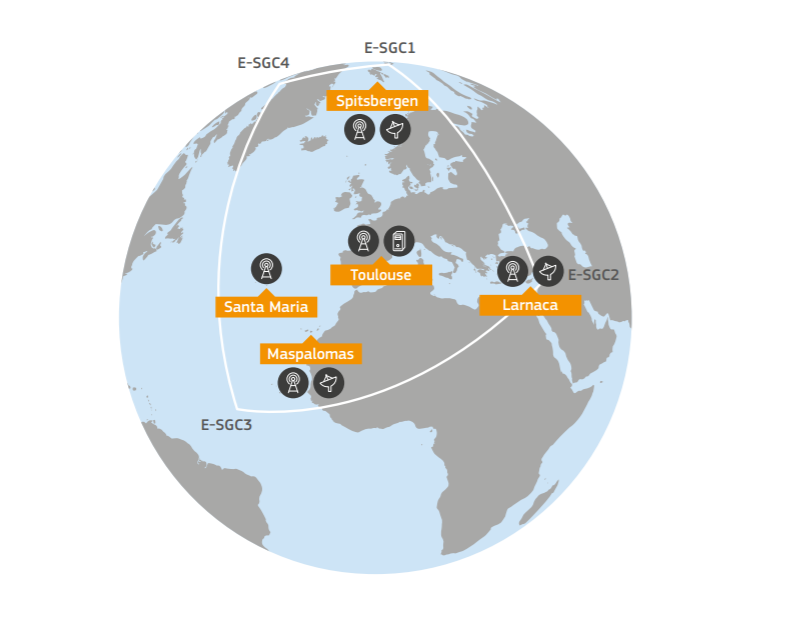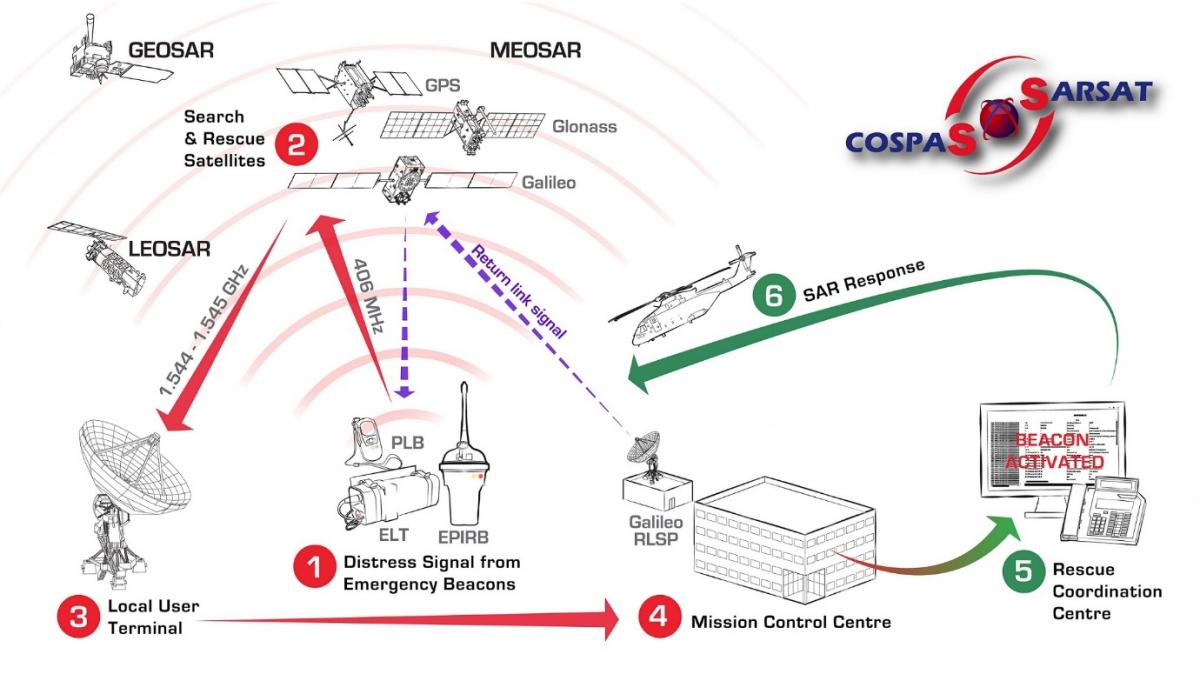Reaching you faster when every second matters
Global Search and Rescue (SAR) operations quickly locate and help people in distress. The SAR/Galileo service, launched on 15 December 2016 as part of Galileo Initial Services, contributes to these live-saving efforts by swiftly relaying radio beacon distress signals to the relevant SAR crews by means of dedicated payloads on-board Galileo satellites, supported by three ground stations strategically deployed across Europe.
On January 21 2020, the SAR/Galileo Return Link Service (RLS) was declared operational. Now, Galileo not only locates people in distress and makes their position known to the relevant authorities, the SAR/Galileo RLS provides an automatic acknowledgement message back to the user informing them that their request for help has been received.
How the SAR/Galileo service works
The SAR/Galileo service is the biggest contributor to the Cospas-Sarsat MEOSAR programme in terms of ground segment and space segment assets. It provides the following two services:
- SAR/Galileo Forward Link: relay of Cospas-Sarsat 406Mhz distress signals to the ground;
- SAR/Galileo Return Link: unique return link alert that informs the sender that their distress alert has been received.
These SAR/Galileo services are fully integrated into the Cospas-Sarsat system. The SAR transponder on Galileo satellites picks up signals emitted from distress beacons in the 406 – 406.1 MHz band and broadcasts this information to dedicated ground stations (MEOLUTs) in the L-band at 1544.1 MHz. These downlink signals transmitted by the Galileo SAR payloads are used by the MEOLUTs to generate an independent location of the beacon, which is then relayed to first responders through dedicated Cospas-Sarsat Mission Control Centres.
What is Cospas-Sarsat?Cospas-Sarsat is a non-profit satellite-based search and rescue distress alert detection and information distribution system. It provides accurate, timely, and reliable distress alert and location data to SAR authorities, increasing the survival chances for people in distress by reducing the time it takes to locate them and relay this information to responders.
COSPAS-SARSAT System Overview |
What it means for you
With contributions from Galileo and other GNSS providers, Cospas-Sarsat has been able to transition from its original design based on satellites in low Earth orbits (LEOSAR), later complemented by geostationary orbit satellites (GEOSAR), towards MEOSAR - a solution based on medium orbit satellites such as Galileo.
The MEOSAR system offer the advantages of both the LEOSAR and GEOSAR systems without their limitations by providing transmission of the distress message and independent location of the beacon, with near-real-time worldwide coverage. Users benefit from:
- Global coverage;
- Single burst detection and location capability;
- Reduced detection time from hours to just minutes after the distress beacon is activated;
- Improved independent GNSS localisation of the distress alert under 5 km or better 95% of the time;
- Improved availability with increased satellite redundancy;
- Better signal detection in difficult terrain and weather conditions;
- Automatic acknowledgment to the person in distress thanks to SAR/Galileo RLS.
With the introduction of the Return Link Service (RLS) Galileo became an even greater differentiator in search and rescue operations. The RLS relies on Galileo’s E1 navigation signal and is available worldwide for RLS-enabled beacons. Thanks to the improvements offered by the SAR/Galileo service, more lives are being saved. Read more here.
Table 1: SAR/Galileo Forward Link Service Location Quality MPLs
Source: Galileo Search and Rescue Service Definition Document table 12, page 30.
Figure 1 - European SAR/Galileo forward link service coverage and SAR/Galileo sites

Source: Galileo Search and Rescue Service Definition Document, figure 3, page 8.
Table 2: SAR/Galileo Forward Link Service Location Accuracy within 2[km] Expected Value
Source: Galileo Search and Rescue Service Definition Document, table 13, page 31.
Table 3: SAR/Galileo Return Link Service Latency and Reception Probability MPLs
Source: Galileo Search and Rescue Service Definition Document, table 16, page 32.
Table 4: End-to-End Return Link Service Delivery Loop Latency Expected Performance
Source: Galileo Search and Rescue Service Definition Document, table 17, page 33.
SAR Market
An enthusiastic market
The installed base of GNSS-enabled SAR beacons is currently about 1.3 mln beacons and this is expected to double by 2029. With close to 95,000 units shipped in 2019, increasing to an expected 150,000 units by 2029, and an installed base of approximately 750,000 units, Personal Locator Beacons (PLBs) constitute the largest group of GNSS-enabled search and rescue beacons sold each year. Emergency Position Indicating Radio Beacons (EPIRBs) are in second place, with an installed base of 500,000 units, followed by Emergency Locator Transmitters (ELTs) with 100,000 units.
PLBs account for around 60% of the global installed base of GNSS-enabled beacons and despite both Automatic Identification System search and rescue transponders (AIS-SARTs) and Automatic Identification System man overboard (AIS-MOBs) forecast to increase their installed base by a CAGR of 14% over the next year (as opposed to only 2% for PLBs), GNSS-enabled PLBs are expected to continue dominating the global installed base in absolute numbers.
One reason for this is the growing share of GNSS uptake across PLBs (92% of produced units in 2018) compared to other SAR beacons such as EPIRBs (47%) and ELTs (32%).
Use Galileo: Up-to-date database of all Galileo-enabled chipsets, receivers and devices
SAR Success Stories
End-to-end solutions based on SAR/Galileo
Several research projects supported by EUSPA under Horizon 2020 are creating end-to-end solutions based on the SAR/Galileo service and leveraging its Return Link.
- HELIOS: The Orolia-led Helios project is developing the next generation of distress beacons by leveraging multi-constellation GNSS, including the Galileo Search and Rescue Service, as well as the MEOSAR system of Cospas-Sarsat. In the scope of the project, the Consortium aims to commercialise ELTs, EPIRBs and PLBs to improve the search and rescue activities in the air, at sea and on land. An objective that has already been realised following the launch of an upgrade to the McMurdo FastFind 220 and Kannad SafeLink Solo PLBs. The project is also contributing to the assessment of potential RLS evolutions. In particular, HELIOS has completed a successful pilot project on remote ELT-DT activation, contributing to aircraft distress tracking.. Learn more.
- SINSIN: The SINSIN project, which builds upon the results of the SAT406M project, aims to develop an enhanced Personal Locator Beacon (PLB) with an embedded EGNSS receiver and leveraging the latest Medium-Earth Orbit Local User Terminal (MEOLUT). This wrist-watch PLB, complying with the Cospas-Sarsat standards, will significantly reduce the localisation of anyone in a distress situation by a factor of 10. Learn more.
- GRIMASSE: The GRIMASSE project is developing tailored beacons and an operational concept based on Galileo SAR to improve SAR detection and response to general aviation aircraft and helicopters in distress situations. The project is developing a cost-effective ELT-DT for general aviation that is easy to plug into the aircraft with minor or no alterations required. It is also building SWIM applications to optimise the exchange of SAR information by RCCs and their responsiveness. Learn more.
In addition, 5 Fundamental Elements projects have been funded to include the RLS in new commercial beacons offered by leading manufacturers:
- TAUCETI, led by OROLIA, is developing a new ELT-Survival;
- iSSAR, led by ECA Aerospace, is developing a new ELT-DT;
- AMETRINE, led by Syrlinks, is focusing on a new PLB;
- PHOENIX, led by Ocean Signal, is developing a new PLB;
- COBALT, led by Marine Rescue Technologies, is developing a new PLB.
Funding opportunities available
To support further uptake of Galileo by beacon manufacturers, EUSPA is offering funding opportunities under its Fundamental Elements programme. Click here to learn more
